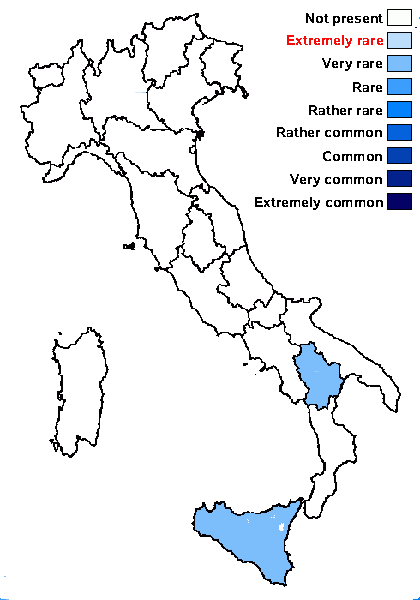Opegrapha rotunda Hafellner
Herzogia, 10: 14, 1994.
Synonyms:
Distribution: S - Bas (Brackel 2011, 2016), Si (Brackel 2008b, 2016).
Description: Thallus inapparent, not lichenized, the hyphae developing inside the thalli of Physconia-species. Apothecia black, epruinose, more or less round, 0.5-1 mm across, with a flat, rough disc, and a somewhat prominent margin, often developing in apical and marginal parts of lobes of the host thallus. Proper exciple dark brown, the marginal hyphae radially arranged; epithecium brown, poorly differentiated from the hymenium; hymenium colourless, c. 100 µm high (incl. epithecium), I+ blue then orange-red, K/I+ blue; paraphysoids branched and anastomosing, the apical cells enlarged, with brown hyphal walls, embedded in a brownish gel. Asci (4-)8-spored, broadly cylindrical to somewhat clavate, fissitunicate, without a K/I+ blue ring-structure in tholus. Ascospores 3-septate, hyaline, somewhat clavate, with unequal cells 18-22 x 5-6 μm, with a thin gelatinous perispore. Photobiont absent. Spot tests: K-, C-, KC-, P-. Chemistry: without lichen substances.Note: this rare species is known only from a single host, Physconia distorta.
Growth form: Lichenicolous fungus
Substrata: bark
Reproductive strategy: mainly sexual
paras Physconia distorta
Commonnes-rarity: (info)
Alpine belt: absent
Subalpine belt: absent
Oromediterranean belt: absent
Montane belt: very rare
Submediterranean belt: very rare
Padanian area: absent
Humid submediterranean belt: very rare
Humid mediterranean belt: very rare
Dry mediterranean belt: very rare

Predictive model
Herbarium samples
Growth form: Lichenicolous fungus
Substrata: bark
Reproductive strategy: mainly sexual
paras Physconia distorta
Commonnes-rarity: (info)
Alpine belt: absent
Subalpine belt: absent
Oromediterranean belt: absent
Montane belt: very rare
Submediterranean belt: very rare
Padanian area: absent
Humid submediterranean belt: very rare
Humid mediterranean belt: very rare
Dry mediterranean belt: very rare

Predictive model
| Herbarium samples |
 Index Fungorum
Index Fungorum
 GBIF
GBIF


